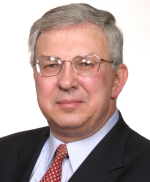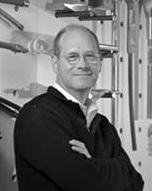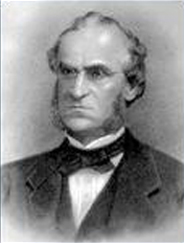
The original One World Trade Center was one of the Twin Towers of the original World Trade Center complex in New York City. It was completed in 1972, stood at a height of 1,368 feet (417 m), and was the tallest building in the world until 1973, when surpassed by the Sears Tower in Chicago.
Leslie Earl Robertson was an American engineer. He was the lead structural engineer of the Twin Towers of the original World Trade Center in New York City, and served as structural engineer on numerous other projects, including the U.S. Steel Tower in Pittsburgh, Shanghai World Financial Center, and the Bank of China Tower in Hong Kong.

The New York University Tandon School of Engineering is the engineering and applied sciences school of New York University. Tandon is the second oldest private engineering and technology school in the United States.

Tung-Yen Lin was a Chinese-American structural engineer who was the pioneer of standardizing the use of prestressed concrete.

Henry Petroski was an American engineer specializing in failure analysis. A professor both of civil engineering and history at Duke University, he was also a prolific author. Petroski wrote over a dozen books – beginning with To Engineer is Human: The Role of Failure in Successful Design (1985) and including a number of titles detailing the industrial design history of common, everyday objects, such as pencils, paper clips, toothpicks, and silverware. His first book was made into the film When Engineering Fails. He was a frequent lecturer and a columnist for the magazines American Scientist and Prism.
The National Academy of Engineering (NAE) is an American nonprofit, non-governmental organization. It is part of the National Academies of Sciences, Engineering, and Medicine (NASEM), along with the National Academy of Sciences (NAS) and the National Academy of Medicine (NAM).

The construction of the first World Trade Center complex in New York City was conceived as an urban renewal project to help revitalize Lower Manhattan spearheaded by David Rockefeller. The project was developed by the Port Authority of New York and New Jersey. The idea for the World Trade Center arose after World War II as a way to supplement existing avenues of international commerce in the United States.
James Glanz is an American journalist who was appointed as Baghdad bureau chief of The New York Times in 2007.
Dr. W. Gene Corley, P.E. was an American structural engineer and "preeminent expert on building collapse investigations and building codes." Corley was the Senior Vice President of CTLGroup from 1987 to 2013, where he led structural engineering projects, including numerous evaluations of buildings and structures damaged by earthquake, explosions, and from terrorist attacks. He led the investigation of structural performance of the Murrah Building following the Oklahoma City bombing in 1995, and the World Trade Center Building Performance Study in 2001–2002 following the September 11, 2001 attacks. He died on March 1, 2013. He was 77.
Daniel Charles Drucker was an American civil and mechanical engineer and academic, who served as president of the Society for Experimental Stress Analysis in 1960–1961, as president of the American Society of Mechanical Engineers in the year 1973–74, and as president of the American Academy of Mechanics in 1981–82.

The original Two World Trade Center was one of the Twin Towers in the original World Trade Center Complex in New York City. The Tower was completed and opened in 1973 at a height of 1,362 feet (415 m) to the roof, distinguishable from its twin, the North Tower, by the absence of a television antenna. On the 107th floor of this building was a popular tourist attraction called "Top of the World Trade Center Observatories," and on the roof was an outdoor observation deck accessible to the public and a disused helipad at the center. The address of this building was 2 World Trade Center, with the WTC complex having its own ZIP code of 10048.

William Frazier Baker is an American structural engineer known for engineering the Burj Khalifa, the world's tallest building/man-made structure and a number of other well known buildings. He is currently a structural engineering partner in the Chicago office of Skidmore, Owings & Merrill, LLP (SOM).
Eric S. Lipton is a reporter at The New York Times based in the Washington Bureau. He has been a working journalist for three decades, with stints at The Washington Post and the Hartford Courant, and he is also the co-author of a history of the World Trade Center.

Louis John Lanzerotti is an American physicist. He is a Distinguished Research Professor of physics in the Center for Solar-Terrestrial Research at New Jersey Institute of Technology (NJIT) in Newark, New Jersey.
Mete Avni Sözen was Kettelhut Distinguished Professor of Structural Engineering at Purdue University, Indiana, United States from 1992 to 2018.

Magnusson Klemencic Associates is an American structural and civil engineering consulting firm with its headquarters in Seattle, Washington. The company has completed projects worth more than $99 billion in 48 states and 54 countries. Significant MKA projects through its history include the World Trade Center, the Columbia Center, Aqua, the Doha Convention Center Tower, the Olympic Sculpture Park, Salesforce Tower, and JW Marriott Indianapolis.

Samuel Charles Florman was an American civil engineer, general contractor and author. He is best known for his writings and speeches about engineering, technology and the general culture. The most widely distributed of his seven books is The Existential Pleasures of Engineering, published in 1976, second edition in 1994. According to one authority, "It has become an often-referred-to modern classic." His last published book was Good Guys, Wiseguys and Putting Up Buildings: A Life in Construction, published in 2012.

James Laurie was a prominent American engineer and one of the founders of American Society of Civil Engineers (ASCE). He performed surveying, bridge design, and route design for a number of railroads in New England.

The original World Trade Center (WTC) was a complex of seven buildings in the Financial District of Lower Manhattan in New York City. Built primarily between 1966 and 1975, it was dedicated on April 4, 1973, and was destroyed during the September 11 attacks in 2001. At the time of their completion, the 110-story-tall Twin Towers, including the original 1 World Trade Center at 1,368 feet (417 m), and 2 World Trade Center at 1,362 feet (415.1 m), were the tallest buildings in the world; they were also the tallest twin skyscrapers in the world until 1996, when the Petronas Towers opened. Other buildings in the complex included the Marriott World Trade Center, 4 WTC, 5 WTC, 6 WTC, and 7 WTC. The complex contained 13,400,000 square feet (1,240,000 m2) of office space and, prior to its completion, was projected to accommodate an estimated 130,000 people.











